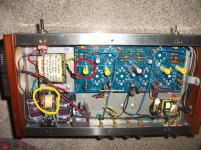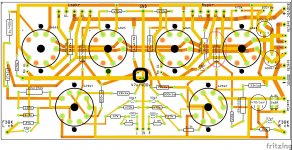WOW! reel to reel.. must be for your personal stash?She sits on top of the equipment rack in the corner.
Since now same issue as OP- Hope its ok to now post findings from previous Q's regarding my same issue.He says he hears a hum difference between channels. I got the amp home and sure enough, one channel is at 0.5mV, the other at 1.1 (inputs shorted, 8 Ohm resistive load)
1. Chassis is non- ferrous
2. Choke remoted mounted, then relocated 90* phase shift from original position(Pic #1- yellow circle)
No difference in L ch hum either change above. Maybe hum induced from close proximity and orientation of PT to L ch signal coupling cap?(Pic #1 red circle)
Perhaps new PCB design (Pic #2 purple circle)which distances L signal coupling cap from PT will cure single channel hum- This is new dive into all triode design- away from pentode preamp stage
To be continued-
Jim
Attachments
Well, it's quittin time - I advised he sell it on ebay and get something better for the vintage money it'll bring.
I replaced the input triode stage cathode resistors with fresher, gold band tolerance parts.
No change - I mean - I'm sorry - made both channels go to 0.5mV - until the next time I turned it on.
Then I swapped input tubes and the output with the larger hum followed the tube. So I replaced them with a set of 7025s I had on hand. Again, made both channels go to 0.5mV - until the next time I turned it on...
I finally wired the tube's heater back to original and removed the dual 68 Ohm hum balancer, which wasnt doing anything measurable. I chickened out on rewiring the driver tubes to one heater winding, the output tubes to the other - only to be foiled by this inanimate object yet again.
The B+ to the output tube screens, the input amp and phase splitter measure just 25mV rms on top of 316V, while the output tranny centertaps have 1V riding on 360.
The input amp triode had now had both the cathode and plate resistors replaced, yet still exhibits the sometimes / sometimes not behavior with this different hum levels in each channel. As I mentioned earlier, shorting the grid to ground of both output tubes gives the best reading - 0.5mV, each channel, with 0.3mV being the amplifier off condition.
It's just that the one channel bounces around between 0.5 and 1.7 depending on the time of day / phase of the moon, while the other remains more or less consistently below 1 mV. Each channel being fed by the same B+ voltages...
The power supply is 5Y3 to 20 uf, resistor to 40 uf (1V on 360V) to trannys. Second resistor to 20 + 40 +20 (25mV on 316V) to screens and input / driver tubes. Sovtek 6BQ5s, Webcor 7025s.
I replaced the input triode stage cathode resistors with fresher, gold band tolerance parts.
No change - I mean - I'm sorry - made both channels go to 0.5mV - until the next time I turned it on.
Then I swapped input tubes and the output with the larger hum followed the tube. So I replaced them with a set of 7025s I had on hand. Again, made both channels go to 0.5mV - until the next time I turned it on...
I finally wired the tube's heater back to original and removed the dual 68 Ohm hum balancer, which wasnt doing anything measurable. I chickened out on rewiring the driver tubes to one heater winding, the output tubes to the other - only to be foiled by this inanimate object yet again.
The B+ to the output tube screens, the input amp and phase splitter measure just 25mV rms on top of 316V, while the output tranny centertaps have 1V riding on 360.
The input amp triode had now had both the cathode and plate resistors replaced, yet still exhibits the sometimes / sometimes not behavior with this different hum levels in each channel. As I mentioned earlier, shorting the grid to ground of both output tubes gives the best reading - 0.5mV, each channel, with 0.3mV being the amplifier off condition.
It's just that the one channel bounces around between 0.5 and 1.7 depending on the time of day / phase of the moon, while the other remains more or less consistently below 1 mV. Each channel being fed by the same B+ voltages...
The power supply is 5Y3 to 20 uf, resistor to 40 uf (1V on 360V) to trannys. Second resistor to 20 + 40 +20 (25mV on 316V) to screens and input / driver tubes. Sovtek 6BQ5s, Webcor 7025s.
Two reasons I do not like the Concertina Phase Inverter:
The Filament to Cathode leakage resistance
The Filament to Cathode capacitance (small, but different hot versus cold).
The Cathode of the concertina is Not bypassed (can not be bypassed, it is not a common cathode circuit).
I have had amplifiers with concertina phase inverters that transferred more than 60Hz hum, they also transferred mid and high frequency Power Mains noise.
And, our ears are more sensitive to those mid frequencies (Ugh!).
Use a concertina, your mileage may vary.
The Filament to Cathode leakage resistance
The Filament to Cathode capacitance (small, but different hot versus cold).
The Cathode of the concertina is Not bypassed (can not be bypassed, it is not a common cathode circuit).
I have had amplifiers with concertina phase inverters that transferred more than 60Hz hum, they also transferred mid and high frequency Power Mains noise.
And, our ears are more sensitive to those mid frequencies (Ugh!).
Use a concertina, your mileage may vary.
The 6EU7 concertinas in MY amp doesn't cause any issues.
Dead silent output, only music comes through, no hums.
And concertina's are well liked for their performance by many.
Naturally balanced by design driving a pair of output tubes.
Read some technical articles, because about the only issue possible in a properly designed concertina amp is limited to being overdriven, and that is only under abuse.
Dead silent output, only music comes through, no hums.
And concertina's are well liked for their performance by many.
Naturally balanced by design driving a pair of output tubes.
Read some technical articles, because about the only issue possible in a properly designed concertina amp is limited to being overdriven, and that is only under abuse.
I got rid of an otherwise perfect amplifier that had lots of high frequency noise
(caused by the filament / cathode of the concertina circuit).
If I knew then what I know now, I might still have that amplifier.
Not all tubes are good for concertina service.
I suspect it has more to do with the manufacturers processes, physical construction, and matterials, than it has to do the the registered tube part number (tube type).
For example, not all 12AU7s are equal.
One old Amperex 12AU7 data sheet said that the filament was spiral (one spiral up, and one spiral down inside the cathode). The insulating filament coating was not specified.
The JJ ECC82-12AU7 has spiral filaments.
Tube science is very interesting.
Pay attention to details.
(caused by the filament / cathode of the concertina circuit).
If I knew then what I know now, I might still have that amplifier.
Not all tubes are good for concertina service.
I suspect it has more to do with the manufacturers processes, physical construction, and matterials, than it has to do the the registered tube part number (tube type).
For example, not all 12AU7s are equal.
One old Amperex 12AU7 data sheet said that the filament was spiral (one spiral up, and one spiral down inside the cathode). The insulating filament coating was not specified.
The JJ ECC82-12AU7 has spiral filaments.
Tube science is very interesting.
Pay attention to details.
Last edited:
Hum cancels in a push-pull output stage, depending on how well the output tubes are matched. So perhaps a new matched set would have helped. But a resistor and capacitor is a whole lot cheaper. Important that your new first cap negative is connected directly to the center tap of the transformer. Connecting it to the nearest chassis ground might increase hum by carrying ripple current in the chassis.
To Tom Bavis, that's right.
It's all about the layout and construction.
I've had to "rewire" chassis plenty of times because of manufacturing shortcuts.
Depending on the chassis for grounding throughout is a flaw of the assembly process.
Remember, those designers were human, so were the assembly line workers.
And humans aren't always "perfect" in their ways.
It's all about the layout and construction.
I've had to "rewire" chassis plenty of times because of manufacturing shortcuts.
Depending on the chassis for grounding throughout is a flaw of the assembly process.
Remember, those designers were human, so were the assembly line workers.
And humans aren't always "perfect" in their ways.
- Status
- This old topic is closed. If you want to reopen this topic, contact a moderator using the "Report Post" button.
- Home
- Amplifiers
- Tubes / Valves
- Reasonable Tube amplifier Hum / Noise

